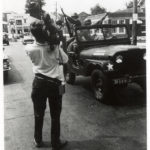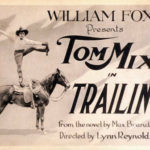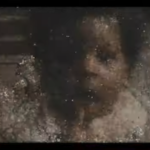Belleville, Looking Like a Great Place to Live
Belleville, New Jersey’s library will use a federal grant to preserve a film homage to the town.
n
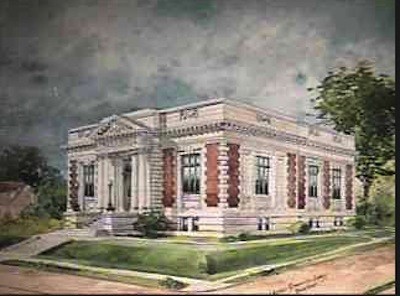
Belleville, New Jersey’s Carnegie Library. Belleville Public Library and Information Center.
In 1934, amateur filmmaker Neil P. Horne made a full-length film to capture the spirit of Belleville, New Jersey. For that legacy, the city can thank Horne’s decision, a few years earlier, to sell his share in a local newspaper to he could buy a motion-picture camera.
That set him on the path to making some 1,500 short films, most about movie stars, politicians, and athletes, including two of his earliest subjects, the then-“world’s fastest human,” James Paddock, and baseball titan Babe Ruth.
In its March/April 1933 issue, Cine-Kodak News noted that “making movies with his Cine-Kodak B of internationally famous men and women is the unique hobby of Mr. Neil P. Horne of Belleville New Jersey. Traveling over 100,000 miles in his cinematographic quest, Mr. Horne has assembled into four 400 ft reels shots of no less than two hundred and sixty noted personages. Skipping through Mr. Horne’s movie diary you come upon celebrities such as Ex-Pres. Hoover, Albert Einstein, Adm. Byrd, Sir Rabindranath Tagore, Babe Ruth, (and on for a dozen or more names.)”
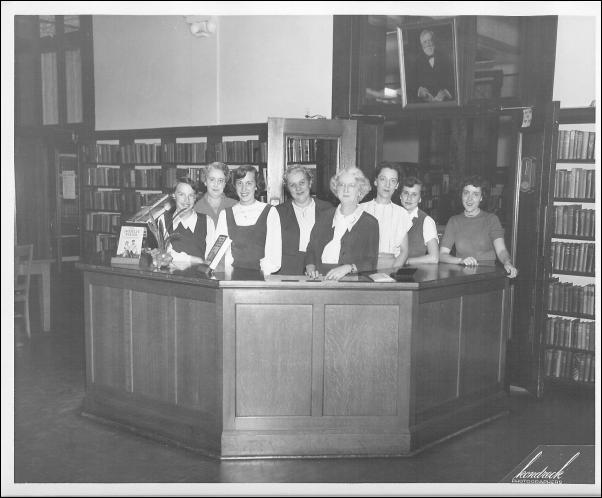
Library Staff 1952. Belleville Public Library and Information Center
n
For his full-length, silent, black-and-white film about Belleville, his then-home town, he spent the 1934 months of February, March, and April trekking about the town recording people and places. Then he set about many hours of editing hundreds of feet of footage into a three-hour film. Later he augmented the results with additional footage from 1928 to 1944, as well as from the 1970s.
Today his Belleville: A Good Place to Live is a rich personal homage to a growing city, Belleville librarians and archivists say. Extensively titled, the silent black-and-white film of Belleville includes historic buildings and sites; residential, business, and industrial sections; town commissioners; police and fire departments; schools and churches; fraternal and civic groups; air views; and special events.
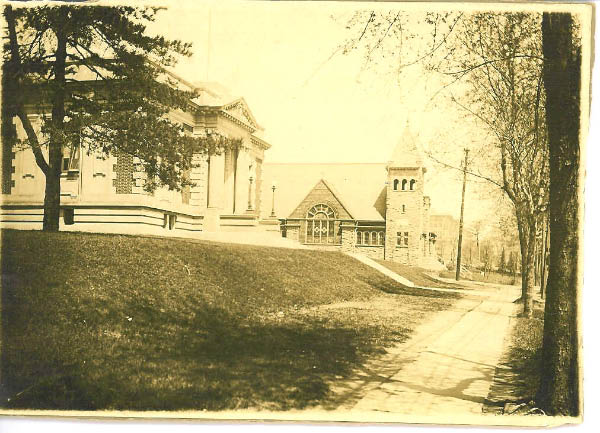 What does all that look like? Showing that is the ambition of the Belleville Library. What archivists and officials there are certain they have is a personal view through film of the kind the National Film Preservation Foundation seeks to protect from the deterioration that time inflicts. The Foundation has awarded a preservation grant to the Belleville Public Library and Information Center. The Library is itself a great attraction — what else Horne found to admire and record will emerge during the next months of restoration.
What does all that look like? Showing that is the ambition of the Belleville Library. What archivists and officials there are certain they have is a personal view through film of the kind the National Film Preservation Foundation seeks to protect from the deterioration that time inflicts. The Foundation has awarded a preservation grant to the Belleville Public Library and Information Center. The Library is itself a great attraction — what else Horne found to admire and record will emerge during the next months of restoration.
In their application to the film-preservation foundation, Belleville archivists wrote: “Footage of everyday scenes of baseball games and football practice or postmen making their rounds will allow current residents to connect with earlier generations of Bellevillites. In the 80 years since Belleville was filmed, all open space has been developed, many major industries have left, new waves of immigrants have moved in. Such changes are common to many communities in suburban northern New Jersey (and elsewhere), but historic film footage is not.”
-
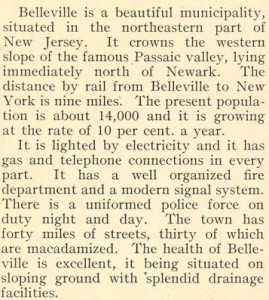
The locals have always thought quite highly of their town, judging by newspaper excerpts.
The film has remained in relatively good shape due to Horne’s having planned for its preservation even as he arranged screenings of it for Belleville residents in 1972 and 1976. “In the Belleville Public Library’s historical collection, the Belleville Historical Society papers and publicity for Mr. Horne’s 1972 showing of the film indicate that the Society was purchasing the film from Mr. Horne at that time,” says Kathy Kauhl, the library’s archivist.
She also notes, however, the vagaries that can lead to films languishing and deterioriating: “I have found documentation that they were $100 short of the $1,000 price. I have not found anything indicating whether the Society actually acquired the film at that time.”
She found that Horne worked with the Society and the Belleville library for several years to locate New York City laboratories that could make a duplicate negative and print. In 1977, he sent directly to the library the seven reels it still has (an eighth, covering Town Hall and town departments, is missing). Now, with its grant from the National Film Preservation Foundation, the library will have work done to safeguard a reel exhibiting recreation, the Library, and clubs.
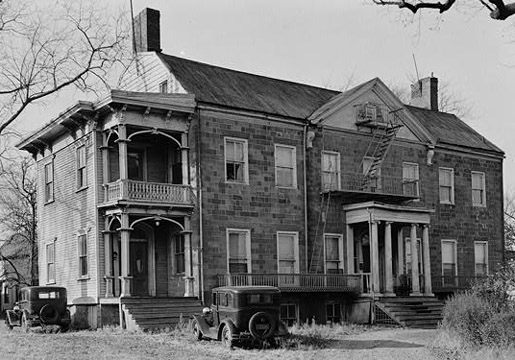
The General Alexander Macomb House, Belleville, erected c. 1784-1797; additions and renovations 1870, as it appeared in 1935. Demolished 1940. Belleville Public Library
Horne wrote in a letter to the editor of a local newspaper in 1974 that he wanted the film to be available to the public. He died in 1979, and because definitive documentation has not been found confirming a donation, his son, Neil P. Horne Jr, has granted to the Library by deed of gift both copyright and internet rights. Kauhl says she believes the Library has the only surviving source material for the film, judging by the library’s own delivery record, the newspaper articles about the film that prompted the filmmaker’s letter to the editor, and Neil Horne Jr’s confirmation of the donation.
In their pitch for a preservation grant from NFPF, Kauhl and her fellow Belleville librarians said residents are eager to have documentation of the history of their city, which has just marked its 175th anniversary as an independent municipality.
It has been around much longer than that. After Dutch and English settlers established it in the 17th century, it was the site of Revolutionary War skirmishes and became the site of a burial ground of 62 Revolutionary War veterans. In the 18th century, when it was called Second River, it became the first settlement to acquire a steam engine, and then the first to build one in America. By the 19th century, the Passaic and Second Rivers provided the power and transportation to make Belleville a leading industrial town, and a scenic one.
 Filming in the 1930s, Horne captured many historic landmarks that have since succumbed to highways and redevelopment, says Kauhl. In addition to images of the town fountain, large estate homes along the river, a Newark-bound trolley, and farmland at its boundary, it displays everyday scenes of baseball games, football practice, and postmen making their rounds.
Filming in the 1930s, Horne captured many historic landmarks that have since succumbed to highways and redevelopment, says Kauhl. In addition to images of the town fountain, large estate homes along the river, a Newark-bound trolley, and farmland at its boundary, it displays everyday scenes of baseball games, football practice, and postmen making their rounds.
In that regard, the film provides residents with views of itself that are attainable in no other way because in the 80 intervening years, all Belleville’s open space has been developed, many major industries have left, and the city’s demography has greatly changed. Kauhl wrote in her application to the NFPF: “Such changes are common to many communities in suburban northern New Jersey and elsewhere, but historic film footage is not. Thus, we anticipate broader interest in this film beyond the residents of this single town.”
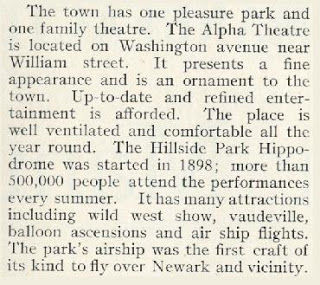 The Belleville library began its life humbly — in a storefront operated by the volunteer Tuesday Afternoon Reading Club — and now serves a population of 36,000 people with holdings of 105,000 volumes. In 1909, the group bought apermanent site from the municipality, and retained the services of a local architect, Charles Granville Jones, who also designed Belleville’s town hall, Methodist church, First National Bank, and old high school. Making the purchase possible was Belleville’s selection to join what would become a network of 2,509 “Carnegie libraries” (1,689 in the United States) built between 1883 and 1929 with donations from Scottish-American industrialist Andrew Carnegie.
The Belleville library began its life humbly — in a storefront operated by the volunteer Tuesday Afternoon Reading Club — and now serves a population of 36,000 people with holdings of 105,000 volumes. In 1909, the group bought apermanent site from the municipality, and retained the services of a local architect, Charles Granville Jones, who also designed Belleville’s town hall, Methodist church, First National Bank, and old high school. Making the purchase possible was Belleville’s selection to join what would become a network of 2,509 “Carnegie libraries” (1,689 in the United States) built between 1883 and 1929 with donations from Scottish-American industrialist Andrew Carnegie.
Belleville librarians plan to place the Horne film with local schools and mount it in the library’s online archive of newspapers, documents, still photos, and other historic materials.
— press release and repotting
Previous Post: Preserving the Colors of Yellowstone
Next Post: Wunderkino 4: Visions of House and Home



